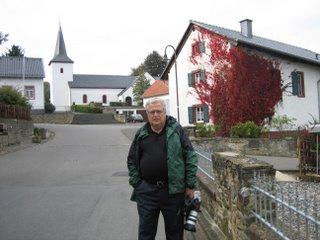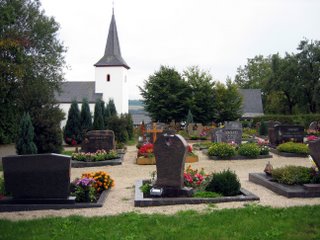Last year we found out the name of the town where my husband's great, great, grandfather lived in Germany. We had attended a family reunion organized by

distant cousins of the family. One cousin had visited Uedelhoven, Germany about ten years ago and had good information on the original emigrees from Germany. This fall when we decided to travel in Germany stopping in this village was at the top of our list.
Uedelhoven is in eastern Germany close to the border of Luxumboerg. It is due east of Koblenz. After seeing Cologne we drove through the rural towns to the village of Uedelhoven. On arrival we were glad to find a gasthaus. It was not open so looking for information Jon knocked on the door of the adjacent house. The adult fetched a teen aged girl who spoke English. She informed us the Gasthaus Pfeffermuhl would open in about an hour at 5:00pm. Jon told her we were looking for our ancestors old house and showed her a picture of his cousin standing by the distinctive door. She recognized it immediately and pointed us to a house on the next strasse.


We found the house and knocked on the door. It was having exterior stucco work done and looked deserted. After knocking a few times a woman in the house next door came out and spoke to us. She did not speak English but gestured for us to stay put. She walked to the nearby school and returned with another teenage girl, her granddaughter Leah who spoke English. When the woman, Rita, found out we were looking for Jon's "Ur,Ur,grossvater's" house she grabbed us and invited us in for kaffee. She told us the history of the house. It was sold by Jon's relative when he emigrated to America to her gr.gr.grandfather. She grew up in the house and after her mother recently died she began renovating it to rent as a vacation home. The house was 400 to 500 hundred years old and is still named after our family. That will never change.
She also told us of a local man who had written a history of the village and its families. Our family no longer has relatives here but there was information on the ones who lived here years ago. She made a call to the writer and arranged for us to meet him the next day. She also called a local woman Hedwig who was related by marriage to the last of the family who lived here. We would go with Rita the next am to meet her. We were overwhelmed with her hospitality.
We did get a "zimmer" at the local gasthaus. We also saw that there was an evening mass at the church where our ancestors belonged and attended that. The priest did not speak English but two local women did and we learned more of the town's history. The graveyard did not have any old tombstones. They only have gravestones for people for about 30 years. They no longer have a boneyard where they store the bones of the long deceased. The family plots are beautifully cared for with fresh flowers growing on the graves and holly trees lining the paths.
The next day we went with Rita to meet Hedwig and her family. Her daughter Hedi translated. They showed showed us two books written in Germany about local families who had gone to America years ago. They were very interested in what had happened to their sons and daughters who had left. I never expected that interest. As we left Hedwig gave Jon a commemorative plate of the church's 850 anniversary.
We also met another young man from Uedelhoven named Peter who spoke excellent English and told us more history. This town is in the Eifel region and dates back 2500 yrs to the Celts and Romans. There are still remnants of ancient aquaducts in the countryside. The aquaducts brought water from the mountains to Cologne. The area is in a Nature Conserve and Germans come to the area to hike.
This village of 300 has been ruled by the Romans, Charlemagne and the Prussians. It outlasted them all. Most people work in nearby towns and commute from here. There is no crime. Some of the houses are empty and many occupied by older residents. Iron and lead were mined nearby until the 1840's. There are still houses and barns with tractors in the village and some cows. The village sits on a small rising and the view of the countryside is lovely.
That night we met with Erwin, the author of the history book, who was the former Burgermeister. He had limited English but we managed a little communication. He told us about a priest relative of our family who had left Uedelhoven in the 1800s to go to America. He spoke eleven languages and was a teacher. He joined a Benedictine Abbey in Pennsylvania and was buried there. We knew immediately who he was talking about and told him the priest did belong to the abbey in PA but was buried at St. John's in Collegeville, MN where our son attends university.
Uedelhoven wasn't what I expected. It was better. The people were so friendly and warm. The day we left Rita saw us out for a walk and waved us over. She gave us a picture of the village taken in 1936 and showed us her photo albums. She then poured us a toast of a blackberry cordial she had made and gave us a bottle to take home along with homemade jam.
We then got a tour of the former family home. There is a neat wood burning oven that can bake ten loaves of bread. She showed us the back bedroom on the main floor which used to house the swine. Next spring this will be ready for rental. I hope some of the family come here to stay.
As we left she said "Auf Weidersein" with tears in her eyes and hugged us. We had tears in our eyes too and will take this place with us in our hearts. Auf Weidersein to all the lovely people in Uedelhoven. I am not of German ancestry and only married into the family but felt included.
 distant cousins of the family. One cousin had visited Uedelhoven, Germany about ten years ago and had good information on the original emigrees from Germany. This fall when we decided to travel in Germany stopping in this village was at the top of our list.
distant cousins of the family. One cousin had visited Uedelhoven, Germany about ten years ago and had good information on the original emigrees from Germany. This fall when we decided to travel in Germany stopping in this village was at the top of our list.

1 comment:
Oh good, another place I can plan to visit! That, and the Baltes schuh factory(http://www.baltes-schuh.de/).
Post a Comment